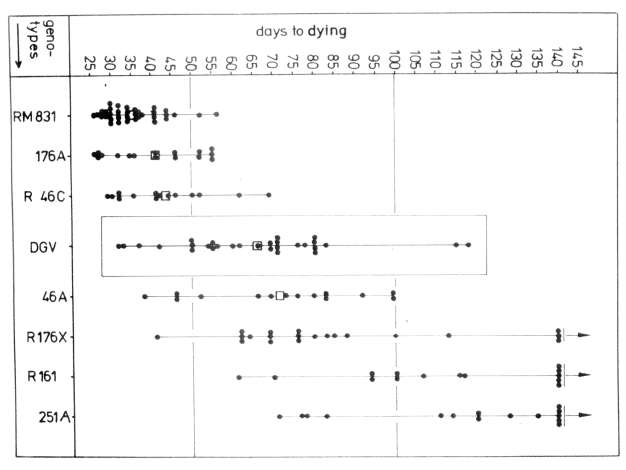HEAT TOLERANCE IN P1SUM
Gottschalk, W.
Institute of Genetics, University of Bonn
D-5300 Bonn 1 , West Germany
Fifty four Pisum genotypes
were studied under short day phytotron conditions with high temperatures
during daytime in order to learn whether there are any differences in the
material with regard to the tolerance against these unfavorable
conditions. Twelve X-ray induced mutants, 39 recombinants and 2 strains
from North Thailand were used for the trials together with the German
variety "Dippes Gelbe Viktoria" (DGV), the mother variety of our mutants.
The phytotron conditions were as follows:
0800 h to 2000 h full light (30,000
lux)
2000 h to 0800 h
darkness
2000 h to 0800 h 15�C
0800 h to 1200 h 1 5�C----->
35�C
1200 h to 1800 h 35�C
1800 h to 2000 h 35�C ----->
15�C
Humidity : 60% The following
criteria were evaluated: number of days from sowing to dying, flowering
behavior, seed production, number of internodes and plant height. The
duration of life of the genotypes
With regard to the duration of life
of the material studied, great differences were found among the genotypes.
Eight genotypes are considered in Fig. 1. Recombinant RM 831, selected
from a cross between the narrow leaved mutant 1 76A and the early
flowering recombinant R 46C, was found to be particularly susceptible to
the high temperature. RM 831 has the following genotypic
constitution:
gene dim for narrow leaflets
and stipules (from 176A),
gene lfa for
earliness (from 46A via R 46C), gene bif-1 for dichotomous stem
bifurcation (from 1201A via R 46C). Most RM 831 plants died very early
without producing flowers (mean time from sowing to death 35.7 d). Mutant
1 76A, one of the parents of RM 831, showed a similar behavior.
In contrast, recombinant R 161 and
the fasciated mutant 251A showed the opposite behavior: they were found to
be very tolerant to the high temperature. A characteristic feature of all
the genotypes studied is the extraordinarily broad variation of the single
values of each genotype although all the plants are homozygous. This
variation is obviously due to non-heritable physiological differences
between the plants of the same genotype. This holds true not only with
regard to the duration of life but also for the other characters
evaluated. The first plant of mutant 251A died 71 d after sowing. At that
time all the plants of RM 831 , 176A and
some other genotypes tested were already dead. The trial was terminated
140 d after sowing. At that time, 5 plants of mutant 251A were still
alive. This behavior was confirmed in a second trial with the same
phytotron conditions. The plants of the short-stemmed fasciated
recombinant R 161 showed a similar behavior to mutant 251A. The values of
all the other genotypes tested, including those of the control material,
lay between these two extremes.

